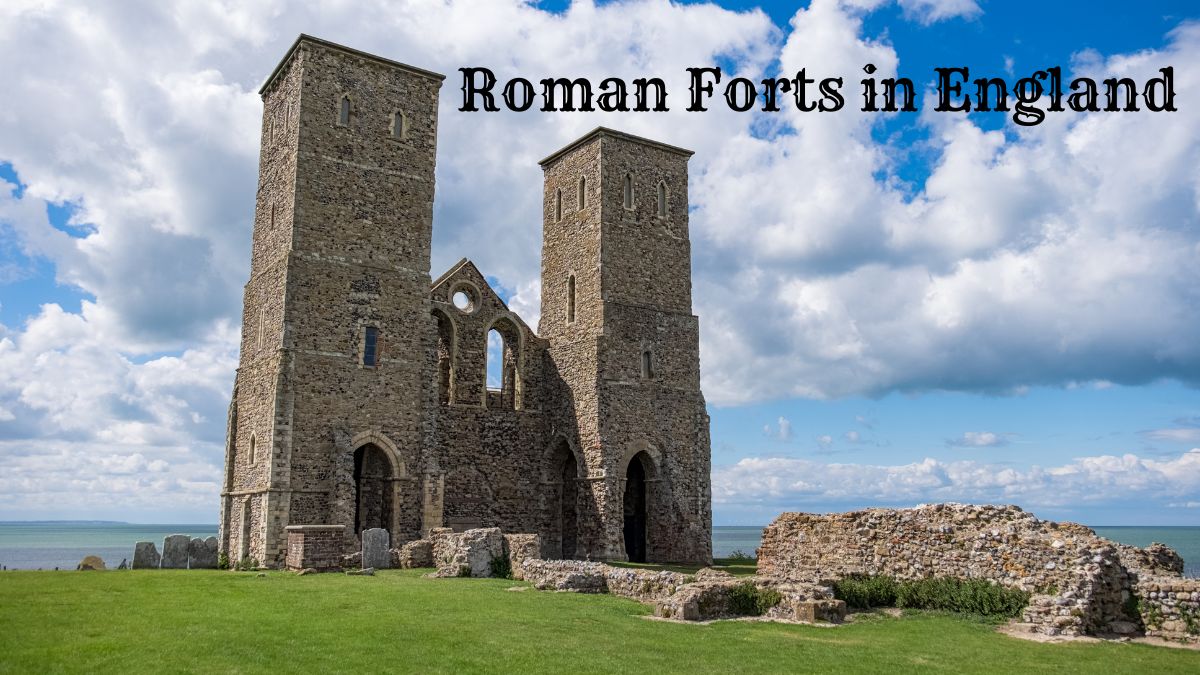Explore the network of Roman forts scattered across England, from the serene coasts to the rugged highlands.
These strongholds, built between the 1st and 5th centuries AD, were more than military installations—they were pivotal in the spread of Roman culture and governance.
Investigating their strategic designs and lasting impacts offers an intriguing look at how these ancient structures shaped modern Britain.
Join us as we journey through time, discovering the architectural wonders and cultural legacy of Rome’s profound influence across England.
Origins of Roman Forts in England
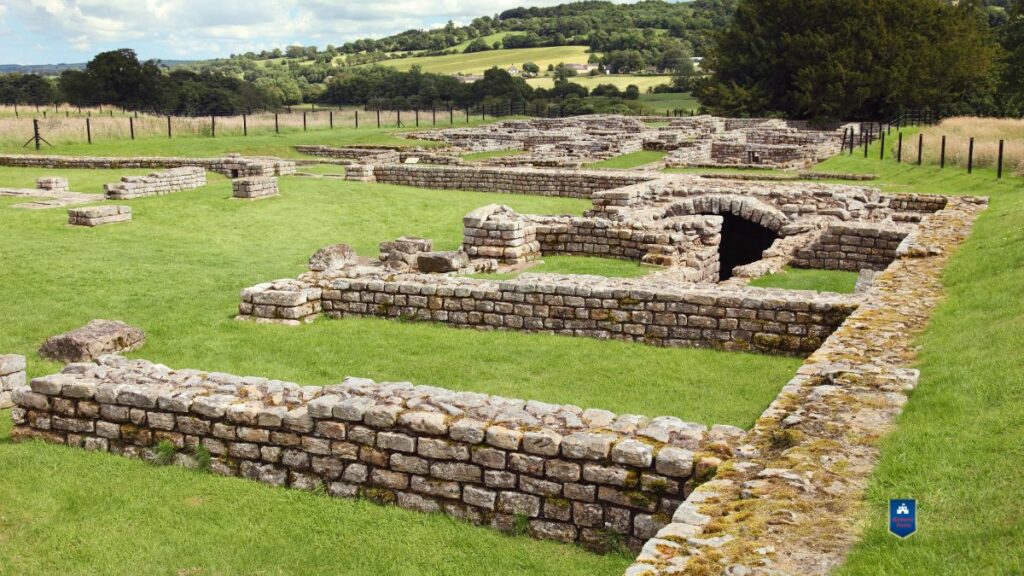
The origin of Roman forts in England traces back to the first century AD when the Roman Empire expanded its reach.
Julius Caesar’s expeditions, initially in 55 and 54 BC, marked the beginning of a presence that would significantly influence Britain, although permanent occupation came later.
First Establishment
Roman military occupation in Britain commenced after the successful invasion led by Emperor Claudius in 43 AD. Forts were strategically established to enforce control over the newly conquered territories and to house the Roman legions.
Strategic Placement
These early forts were primarily concentrated along the coast to deter further attacks and facilitate supply routes.
Inland forts arose, serving as logistical hubs and as part of a larger network for swift military response and troop movement.
- Materials and Construction
- Initially temporary: wood and earth
- Later, it was replaced by stone structures
Role and Evolution
Roman forts served multiple purposes, from imposing military might to fostering Roman culture.
Over time, many evolved into towns and cities. London (Londinium) and Chester (Deva Victrix) are examples of such evolutions, with remnants still visible today.
Forts also maintained connections with continental Europe, asserting the reach of Roman Britain as part of the broader Roman Empire.
Legacy
Archaeological evidence of Roman forts provides insights into military organization, architecture, and daily life during Roman rule in Britain.
The forts built over two thousand years ago remain an essential part of the English historical landscape, and studying these sites offers valuable information about the broader tactics and strategies of Rome’s military expansion.
The Architecture of Roman Forts

Roman forts in England showcased impressive architectural designs adapted to military needs and their inhabitants’ well-being.
The structures were rectangular with rounded corners, characterized by organized layouts that included a commanding officer’s house, barracks, granaries, and workshops.
Stone Walls
Roman forts traditionally had stone walls that formed the perimeter. These walls were often interspersed with towers and gatehouses, providing a sturdy defense against potential invaders.
The walls could reach significant heights as a physical and psychological barrier.
Defensive Features
Forts were typically surrounded by defensive ditches known as ‘Valli.’ Their principal entrance was through towering walls designed to deter and defend against attacks.
Central Heating
Inside the fort, buildings with important functions, such as the commanding officer’s quarters and hospitals, frequently included hypocausts – an early form of central heating.
This system showcased the Romans’ advanced knowledge of engineering and architecture, providing warmth to the stone structures during the cooler climate.
Bath House
The presence of a bathhouse within the fort was not unusual.
This amenity served both hygienic and social functions. It exhibited complex engineering, with underfloor heating and hot and cold rooms. It was a place where soldiers could relax and maintain their health.
Forts played a crucial role in the Roman strategy of occupation and control.
The architecture of these forts reflects the Romans’ ingenuity and their understanding of the importance of structure and organization in maintaining their empire.
Roman Military Presence
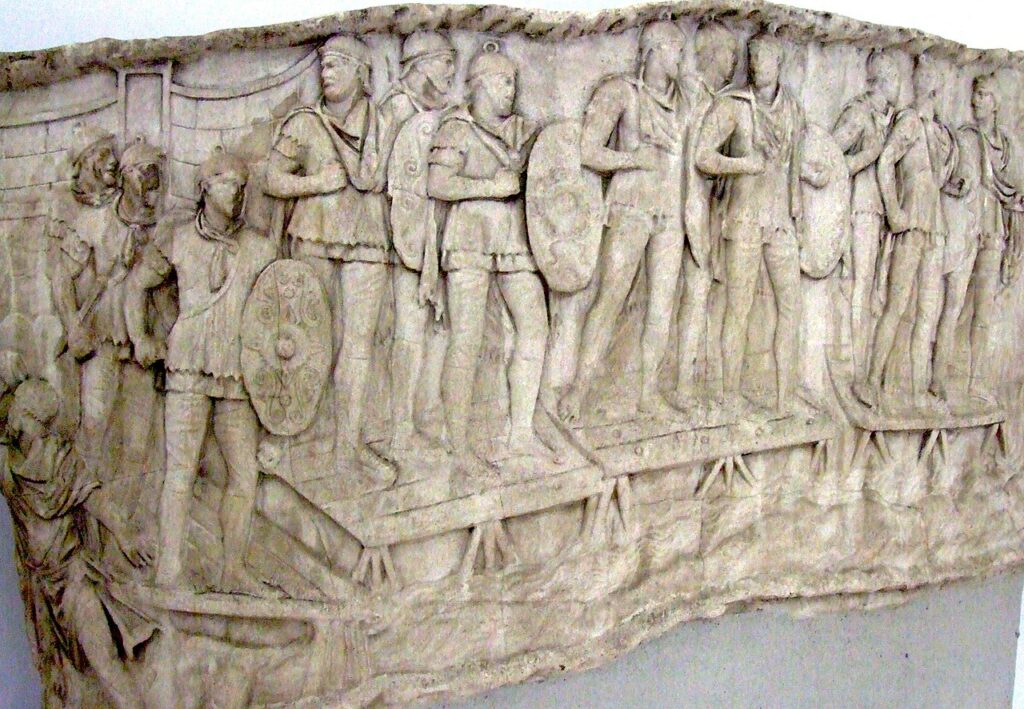
The Roman military was integral to the occupation and control of England. Establishing forts was pivotal in maintaining the Roman garrison across the region.
Roman Army
The Roman Army in Britain was composed of various units, including legions, auxiliaries, and cavalry. They were tasked with defense, conquering new territories, and maintaining order.
The Roman occupation of Britain began in 43 AD and lasted for almost four centuries, with the army ensuring control over this distant province of the Roman Empire.
Roman Legions
Britain was garrisoned by several Roman Legions, each comprising roughly 5,000 heavily armed and trained professional soldiers.
Key forts such as Isca Augusta (Caerleon) and Eboracum (York) served as headquarters for legions such as the Second Augusta and the Sixth Victrix, respectively.
These legions were crucial for asserting Roman dominance in England through their strategic placement and formidable presence.
Roman Soldiers
Roman Soldiers were typically stationed in forts along key points, such as the famous Hadrian’s Wall, or in major towns.
They lived in barracks with a fortress, often accommodating a garrison of a single legion.
Life in these garrisons was disciplined and structured. Soldiers focused on military readiness and training. They also undertook construction projects that supported the province’s Roman military and administrative infrastructure.
Important Roman Fort Locations

Roman forts were integral to ancient Britain’s military strategy. They served as defensive structures and administrative centers, and their strategic positioning allowed for effective control over the region.
Hadrian’s Wall
Homestead Roman Fort sits atop Hadrian’s Wall, a defensive fortification in the north, and is one of the complete Roman forts in Britain.
English Heritage manages it, and the wall is part of the UNESCO World Heritage Site. This fort features well-preserved remains and the Vindolanda writing tablets, which provide insight into the daily lives of Roman soldiers.
Antonine Wall
The Antonine Wall, now primarily ruins, was Britain’s northwest frontier of the Roman Empire. Its remains are less prominent than its southerly counterpart, Hadrian’s Wall.
However, some forts and foundations are still visible today.
Northern England
In Northern England, the Hardknott Roman Fort exemplifies a remote military stronghold. Perched in the Lake District hills, it offers a glimpse into the challenges faced by Roman troops stationed in the region’s harsh landscape.
Scottish Border
The Scottish Border hosts sites deeply interwoven with the Roman campaigns against the native tribes. The Romans established forts as outposts to manage and influence these northern areas.
They aimed to secure the frontier of the Roman province.
Civilian Life and Structures
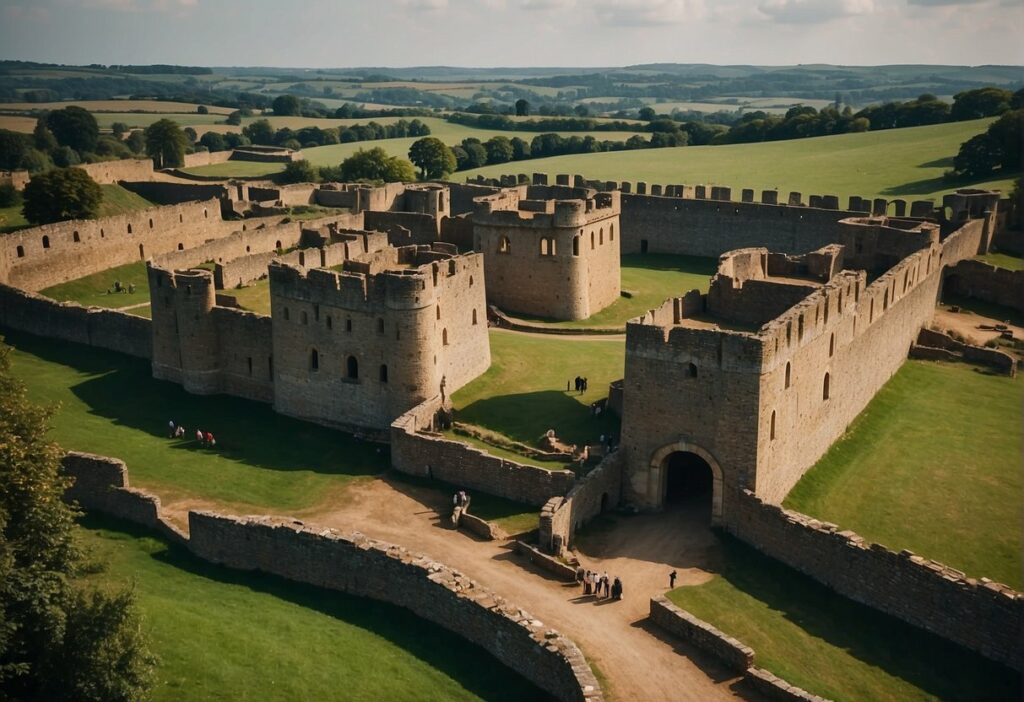
The Roman presence in England brought about not only military installations but also sophisticated structures that catered to civil life, including urban centers, public baths, and private residences.
Roman Towns and Cities
Roman towns and cities in England were centers of administration, commerce, and daily life. They featured a grid system of streets with a forum, public buildings, and often an amphitheater.
Urban areas like Londinium (London) became significant economic hubs.
Roman Baths
Public baths were integral to Roman society, offering more than hygiene. They served as social venues and places for relaxation and business.
Bath is home to one of the best-preserved Roman bathhouses built around natural hot springs, underscoring the importance of such structures in Roman culture.
Roman Villas
Private homes, known as Roman villas, reveal much about the domestic life of the elite. Fishbourne Roman Palace and Chedworth Roman Villa are prominent examples.
Fishbourne is notable for its large size and luxurious mosaic floors, while Chedworth showcases innovations like underfloor heating systems, indicating a high standard of living.
- Bignor Roman Villa: This site features beautiful mosaics and offers insights into agricultural life in Roman Britain. It displays the wealth and comforts its owners enjoy through its elaborate design and décor.
- Public Baths: Common in Roman towns, these complexes included hot baths (caldarium), warm rooms (tepidarium), and cold baths (frigidarium), illustrating the sophistication of Roman engineering and their emphasis on community and cleanliness.
Roman Heritage Sites

England is home to numerous well-preserved Roman forts and sites, many of which are under the stewardship of organizations like English Heritage and the National Trust.
These sites provide a window into the Roman occupation of Britain and highlight the sophisticated military, architectural, and social innovations of the time.
Hadrian’s Wall is perhaps England’s most famous example of Roman military engineering.
Stretching across the north of England from the North Sea to the Irish Sea, the wall marks the Roman Empire’s northern boundary and includes several forts, such as Housesteads and Chesters, managed by English Heritage.
Table: Significant Roman Forts and Sites in England
| Name | Location | Managed By | Key Features |
|---|---|---|---|
| Hadrian’s Wall | Northern England | English Heritage | Served as the northern frontier of the Roman Empire |
| Housesteads Fort | Hadrian’s Wall | English Heritage | Well-preserved fort with a museum |
| Chesters Roman Fort | Hadrian’s Wall | English Heritage | Remains of a cavalry fort and bathhouse |
| Fishbourne Roman Palace | West Sussex | Independent | Largest residential Roman building discovered in Britain |
| Chedworth Roman Villa | Gloucestershire | National Trust | One of the largest Roman villas in Britain |
In West Sussex, Fishbourne Roman Palace is recognized for its vast mosaics and extensive grounds. Owned by an independent charity, the site offers valuable insight into the luxurious lifestyles of Roman Britain’s elite.
Another remarkable site is Chedworth Roman Villa in Gloucestershire, where the National Trust oversees the conservation of one of the largest Roman villas in the country.
The villa’s intricate mosaics and bathhouse complex highlight the prosperity experienced during Roman times.
Roman Cultural Influence
The Roman occupation brought military prowess to England and profound changes in cultural practices.
Roman temples stood as symbols of the new architectural order.
Worship practices merged with local traditions, creating hybrid forms of religious expression.
The Romans introduced sophisticated garden designs significantly different from the local agrarian landscapes.
Large Roman villas often featured elaborate gardens, which served as a place for leisure, horticulture experiments, and social gatherings.
These gardens often included ornamental plants, geometric arrangements, and water features, which were novel in England then.
Large Roman villas, still in ruins today, were opulent residences showcasing their owners’ wealth and cultural sophistication.
The villas were often outfitted with hypocaust heating systems, intricate mosaics, and painted walls, setting a precedent for domestic comfort and interior decoration.
Roman cultural imprints also pertained to the mundane, such as food and drink habits, which changed with new eating patterns and dining etiquette.
The comprehensive incorporation of these various influences into the native culture ultimately laid a foundation for the English lifestyle that would follow in the succeeding centuries.
Excavations and Archaeological Insights
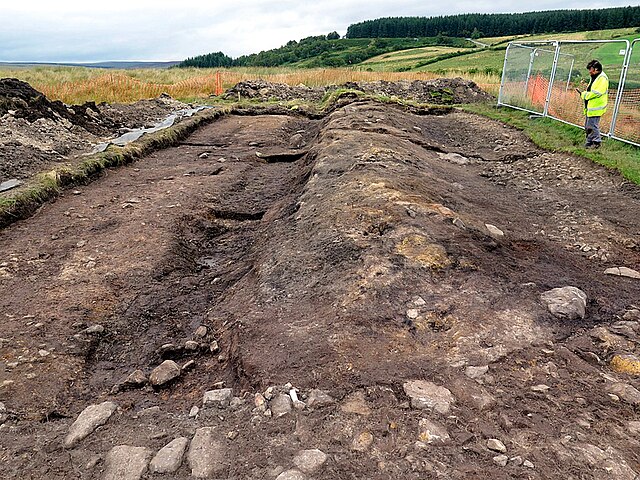
Archaeological digs at various Roman forts across England have illuminated the lives of soldiers and settlers during the Roman occupation.
A notable site is Hadrian’s Wall,, where extensive excavations have uncovered barracks, weapons, and personal items illuminating daily military life.
Recent diggings at Vindolanda, close to the wall, revealed well-preserved wooden writing tablets.
These are some of the oldest surviving handwritten documents in Britain, offering insights into the administration and communications of the fort.
Archaeologists discovered a well-preserved mosaic floor at the site of a Roman villa in Chedworth, Gloucestershire.
The patterns and craftsmanship provide evidence of the artistic and cultural influences within Roman Britain and point to the wealth and status of the occupants.
Significant finds often end up on display at the British Museum.
Here, artifacts such as intricate jewelry, Roman glass, and pottery help construct a more complete image of Roman societal and domestic practices.
| Site | Key Findings |
|---|---|
| Vindolanda | Wooden writing tablets |
| Chedworth | Mosaic floors |
| British Museum | Artifacts including jewelry and pottery |
Key Subjects:
- Roman forts
- Daily military life
- The oldest surviving handwritten documents
- Artistic influences
- Display of artifacts at the British Museum
Further excavations and meticulous analyses promise to provide more information about this historical segment.
Classical Roman Sites
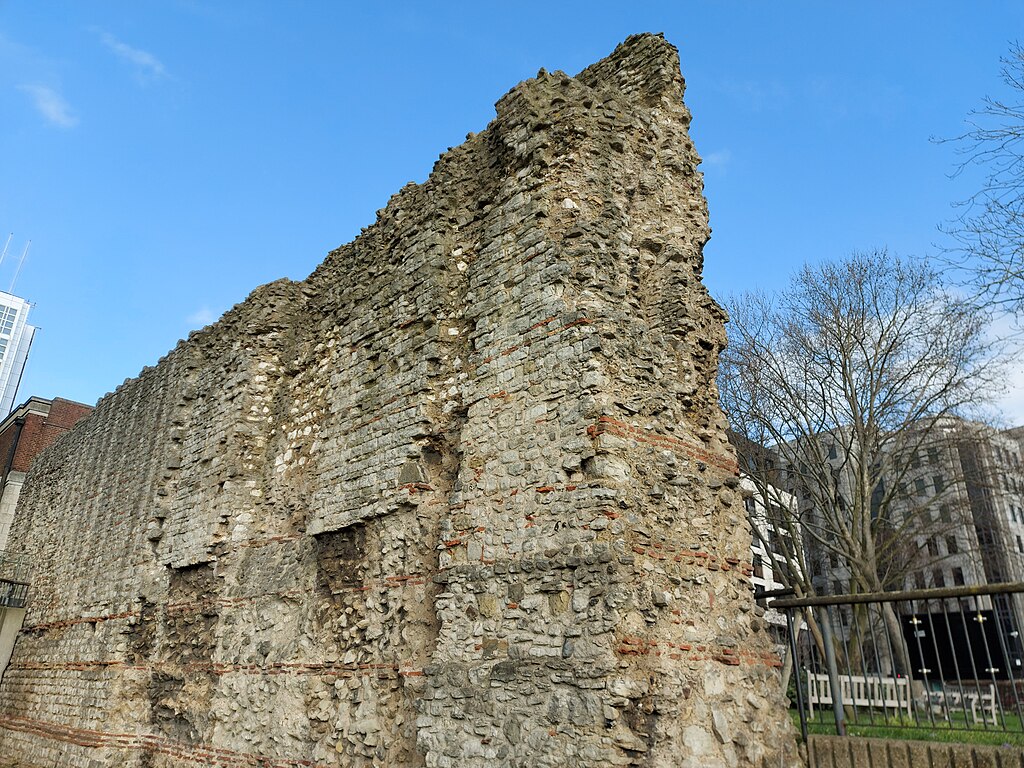
England harbors several significant Roman archaeological sites, which reflect the once extensive reach of the Roman Empire.
Among these, specific sites stand out for their historical value and the wealth of finds they offer to both scholars and visitors.
Museums
Roman Vindolanda and the London Mithraeum are key locations where Roman artifacts from England are displayed.
The former is home to the Vindolanda tablets, some of the most important finds of the Roman Empire, giving insight into daily life on the edge of the Roman world. Below is a brief overview of these museums:
- Vindolanda Museum
- Location: Chesterholm, Hexham, Northumberland
- Highlights: Vindolanda tablets, military equipment, and personal items of the Romans.
- London Mithraeum
- Location: Bloomberg SPACE, 12 Walbrook, London
- Highlights: Roman Temple of Mithras, multimedia experience, and a collection of Roman artifacts discovered during recent excavations.
Most Famous Ruins
Regarding ruins, the London Wall and the structures within the City of London provide tangible remnants of the ancient city’s past.
The London Wall was a defensive structure erected by the Romans, parts of which can still be seen today. Pertinent details of these ruins include:
- London Wall
- Portions are near Tower Hill, Barbican, and the Museum of London.
- Visible remains: Sections of the wall, remnants of fortifications.
- City of London
- Contains sites like the Roman Amphitheatre under the Guildhall Art Gallery.
- Notable features: The layout of ancient Londinium’s streets and the Roman house remain.
Preservation and Conservation
Efforts to preserve Roman forts in England have been ongoing, with organizations such as English Heritage and the National Trust at the forefront.
Preservation activities are vital for maintaining these historic structures, which provide insight into England’s Roman past and medieval developments.
The Hadrian’s Wall, a well-known Roman fortification, is one exemplar requiring regular conservation work to manage the impacts of weathering and tourism.
Conservation Practices:
- Structural Stabilization: Maintenance of walls and foundations to prevent collapse.
- Environmental Management: Control of vegetation and erosion that threaten site integrity.
- Visitor Management: Balancing public access with the protection of fragile remains.
Protection Legislation:
The forts are protected under UK law, ensuring that any restorative work is sensitive to the sites’ historical fabric. This legal framework is crucial in safeguarding these monuments for future generations.
Challenges Faced:
- Climate Change: Increased rainfall and temperatures from climate change pose risks to the sites, particularly coastal ones near the English Channel.
- Funding: Adequate resources are essential for ongoing maintenance and emergency repairs.
Public Engagement:
Education about the significance of these sites encourages public support for preservation efforts. Many forts feature interactive displays and reenactments from medieval times to engage visitors.
Explore More: Historic Forts in Bermuda
Roman Forts in Popular Culture
Roman forts have been depicted in various forms of popular culture, often highlighting their historical significance and architectural prowess.
These ancient structures occasionally appear in film, literature, and television, generally serving as a backdrop to narratives set during the Roman period in Britain.
For example, Roman forts are sometimes used as settings in historical fiction novels. Authors often describe the robust design of these forts to help readers visualize the era’s military strength.
In films and TV shows, replicas of forts provide an authentic backdrop, transporting viewers to ancient times.
While not directly connected to Roman forts, Buckingham Palace stands upon a nation whose foundations were influenced by Roman fortifications, such as the London City Wall.
Roman forts within the cultural landscape are a subtle reminder of Rome’s once expansive control over Britain.
City walls, like those that once surrounded London, can trace their lineage back to the methods used in constructing Roman forts.
The evolution of such fortifications can be seen in the remnants of ancient walls that withstood the progression of time well into the Middle Ages.
These remaining sections of the London City Wall draw tourists interested in the city’s layered past.
Roman forts are often recreated in video games with meticulous attention to detail, offering an interactive experience that allows players to ‘walk’ through these historical military encampments.
These virtual reconstructions sometimes extend to include the city walls and integrate educational elements about daily life within Roman forts.

Cory is a website owner and content creator who enjoys fishing, history, coin collecting, and sports, among other hobbies. He is a husband and father of four.
Romans 15:4 For whatever was written in former days was written for our instruction, that through endurance and through the encouragement of the Scriptures we might have hope.

